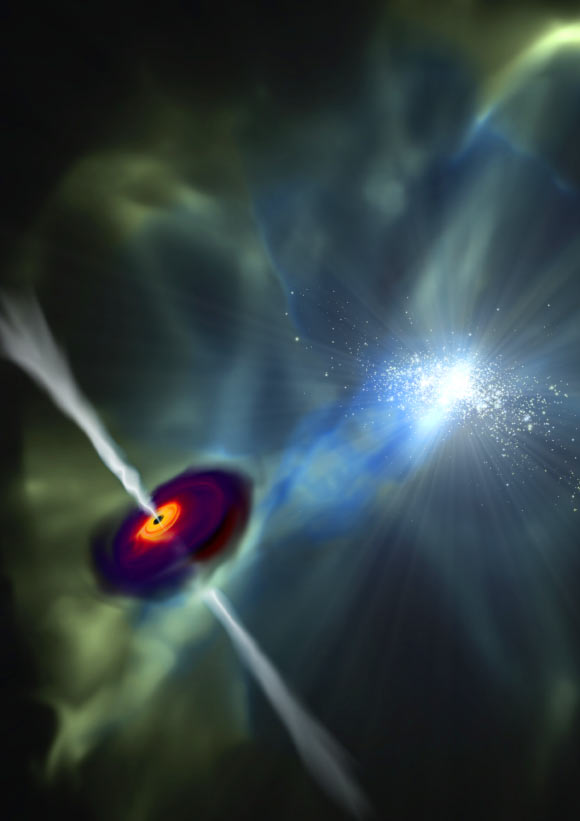An international team of astrophysicists from the United States, Ireland and Finland has come up with the formula for the formation of the first supermassive black holes in the Universe.

The massive black hole shown at left in this drawing is able to rapidly grow as intense radiation from a galaxy nearby shuts down star formation in its host galaxy. Image credit: John Wise, Georgia Tech.
Supermassive black holes live at the center of very large galaxies, including our own galaxy, the Milky Way.
How these giant black holes came into being has perplexed astrophysicists for a long time.
A novel theoretical model developed by Dublin City University researcher John Regan and co-authors provides a compelling solution by using the radiation from neighboring galaxies as a catalyst for forming supermassive black hole seeds.
“Understanding how supermassive black holes form tells us how galaxies, including our own, form and evolve, and ultimately, tells us more about the universe in which we live,” Dr. Regan said.
In computer simulations, he and his colleagues show that a black hole can rapidly grow at the center of a protogalaxy if a nearby protogalaxy emits enough radiation to switch off its capacity to form stars.
Thus disabled, the host protogalaxy grows until its eventual collapse, forming a black hole that feeds on the remaining gas, and later, dust, dying stars, and possibly other black holes, to become super gigantic.
“When protogalaxies are in close proximity, the powerful radiation field of one protogalaxy sterilizes the other, thus disabling its ability to form stars,” the scientists explained.
“The sterilized galaxy continues to grow in mass however, quickly reaching a critical threshold beyond which the formation of a massive black hole is inevitable.”
“These massive black holes then continue to gather up any materials that come into their radius including other black holes and stars.”
“The most ravenous grow their mass by a factor of nearly a million and it is these black holes we see as quasars shining across the length of the Universe,” they said.
“The nearby galaxy can’t be too close, or too far away, and like the Goldilocks principle, too hot or too cold,” noted team member Dr. John Wise, from Georgia Tech.
“The collapse of the galaxy and the formation of a million-solar-mass black hole takes 100,000 years — a blip in cosmic time,” added team member Prof. Zoltan Haiman, from Columbia University.
“A few hundred-million years later, it has grown into a billion-solar-mass supermassive black hole. This is much faster than we expected.”
The team’s findings were published online March 13 in the journal Nature Astronomy.
The researchers hope to test their theory when NASA’s James Webb Space Telescope, the successor to Hubble, goes online next year and beams back images from the early Universe.
_____
John A. Regan et al. 2017. Rapid formation of massive black holes in close proximity to embryonic protogalaxies. Nature Astronomy 1, article number: 0075; doi: 10.1038/s41550-017-0075







